Executive Leadership Report: NZ Business Leadership and Innovation
VerifiedAdded on 2023/04/08
|17
|4126
|386
Report
AI Summary
This report provides a critical evaluation of executive leadership within New Zealand-based organizations, focusing on the impact of leadership theories on organizational behavior, culture, and vision. The report explores the role of entrepreneurial thinking, creativity, and innovation, supported by case studies of six NZ companies from various sectors including engineering, software, airlines, food and beverage, fuel distribution, and grocery. It examines leadership styles such as transformational, motivational, and democratic leadership, and their effects on organizational dynamics. The report also delves into entrepreneurial thinking, innovation, and knowledge management, using academic theories and real-world examples to support its analysis. The conclusion summarizes the findings, offering recommendations for business sustainability and acknowledging the limitations of the study.

Running Head: EXECUTIVE LEADERSHIP
Topic- Report on Executive Leadership
Student name
University name
Author notes
Topic- Report on Executive Leadership
Student name
University name
Author notes
Paraphrase This Document
Need a fresh take? Get an instant paraphrase of this document with our AI Paraphraser
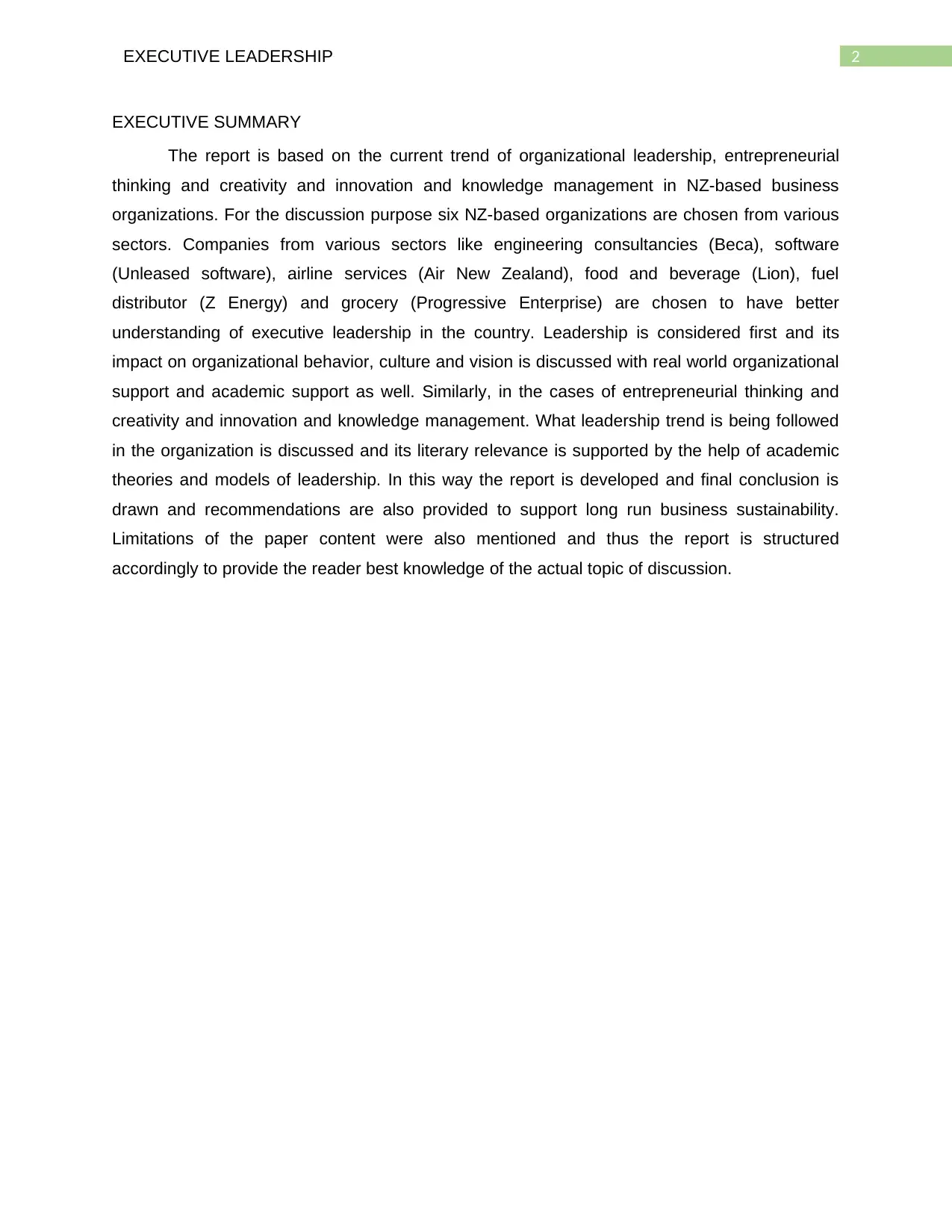
2EXECUTIVE LEADERSHIP
EXECUTIVE SUMMARY
The report is based on the current trend of organizational leadership, entrepreneurial
thinking and creativity and innovation and knowledge management in NZ-based business
organizations. For the discussion purpose six NZ-based organizations are chosen from various
sectors. Companies from various sectors like engineering consultancies (Beca), software
(Unleased software), airline services (Air New Zealand), food and beverage (Lion), fuel
distributor (Z Energy) and grocery (Progressive Enterprise) are chosen to have better
understanding of executive leadership in the country. Leadership is considered first and its
impact on organizational behavior, culture and vision is discussed with real world organizational
support and academic support as well. Similarly, in the cases of entrepreneurial thinking and
creativity and innovation and knowledge management. What leadership trend is being followed
in the organization is discussed and its literary relevance is supported by the help of academic
theories and models of leadership. In this way the report is developed and final conclusion is
drawn and recommendations are also provided to support long run business sustainability.
Limitations of the paper content were also mentioned and thus the report is structured
accordingly to provide the reader best knowledge of the actual topic of discussion.
EXECUTIVE SUMMARY
The report is based on the current trend of organizational leadership, entrepreneurial
thinking and creativity and innovation and knowledge management in NZ-based business
organizations. For the discussion purpose six NZ-based organizations are chosen from various
sectors. Companies from various sectors like engineering consultancies (Beca), software
(Unleased software), airline services (Air New Zealand), food and beverage (Lion), fuel
distributor (Z Energy) and grocery (Progressive Enterprise) are chosen to have better
understanding of executive leadership in the country. Leadership is considered first and its
impact on organizational behavior, culture and vision is discussed with real world organizational
support and academic support as well. Similarly, in the cases of entrepreneurial thinking and
creativity and innovation and knowledge management. What leadership trend is being followed
in the organization is discussed and its literary relevance is supported by the help of academic
theories and models of leadership. In this way the report is developed and final conclusion is
drawn and recommendations are also provided to support long run business sustainability.
Limitations of the paper content were also mentioned and thus the report is structured
accordingly to provide the reader best knowledge of the actual topic of discussion.
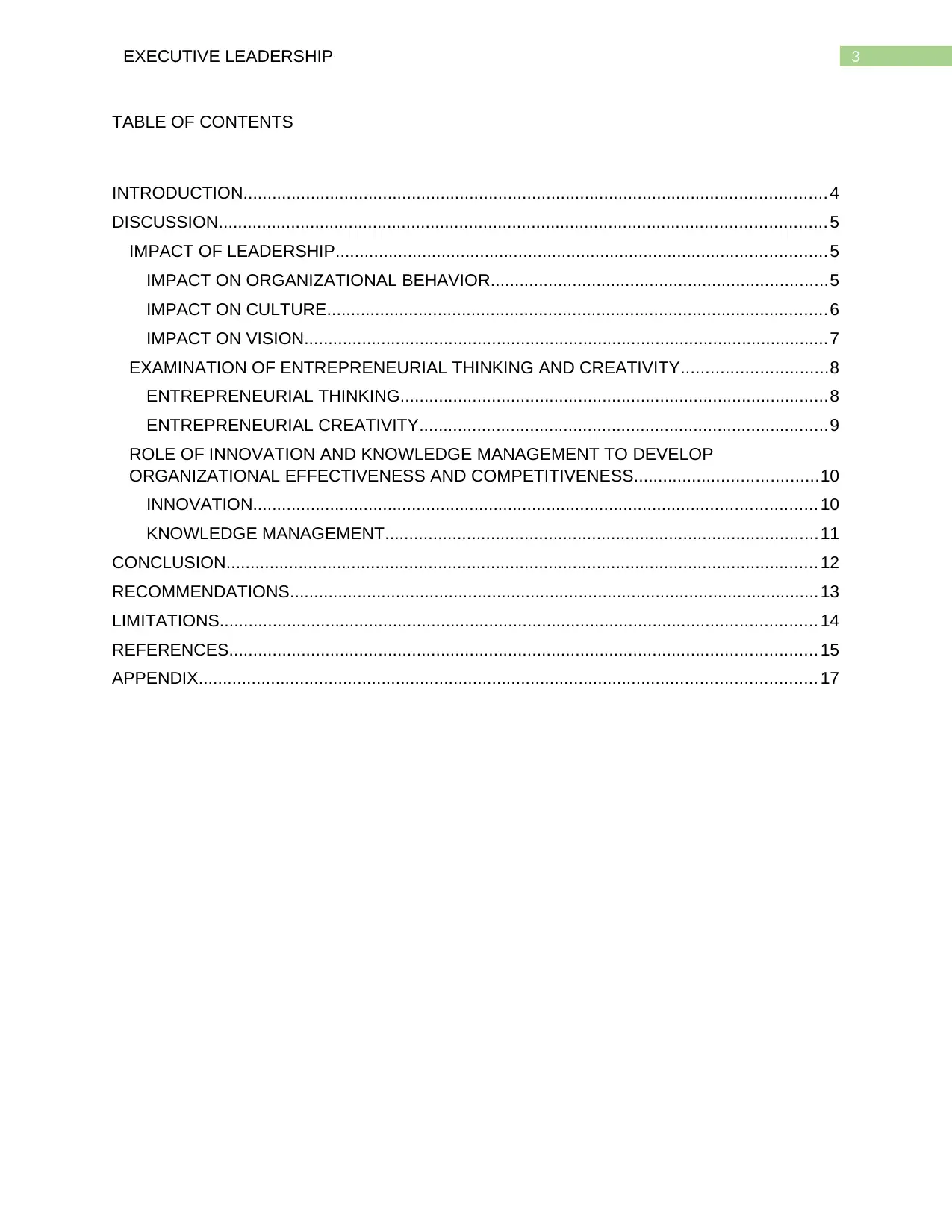
3EXECUTIVE LEADERSHIP
TABLE OF CONTENTS
INTRODUCTION......................................................................................................................... 4
DISCUSSION.............................................................................................................................. 5
IMPACT OF LEADERSHIP......................................................................................................5
IMPACT ON ORGANIZATIONAL BEHAVIOR......................................................................5
IMPACT ON CULTURE........................................................................................................6
IMPACT ON VISION.............................................................................................................7
EXAMINATION OF ENTREPRENEURIAL THINKING AND CREATIVITY..............................8
ENTREPRENEURIAL THINKING.........................................................................................8
ENTREPRENEURIAL CREATIVITY.....................................................................................9
ROLE OF INNOVATION AND KNOWLEDGE MANAGEMENT TO DEVELOP
ORGANIZATIONAL EFFECTIVENESS AND COMPETITIVENESS......................................10
INNOVATION..................................................................................................................... 10
KNOWLEDGE MANAGEMENT..........................................................................................11
CONCLUSION........................................................................................................................... 12
RECOMMENDATIONS.............................................................................................................. 13
LIMITATIONS............................................................................................................................ 14
REFERENCES.......................................................................................................................... 15
APPENDIX................................................................................................................................ 17
TABLE OF CONTENTS
INTRODUCTION......................................................................................................................... 4
DISCUSSION.............................................................................................................................. 5
IMPACT OF LEADERSHIP......................................................................................................5
IMPACT ON ORGANIZATIONAL BEHAVIOR......................................................................5
IMPACT ON CULTURE........................................................................................................6
IMPACT ON VISION.............................................................................................................7
EXAMINATION OF ENTREPRENEURIAL THINKING AND CREATIVITY..............................8
ENTREPRENEURIAL THINKING.........................................................................................8
ENTREPRENEURIAL CREATIVITY.....................................................................................9
ROLE OF INNOVATION AND KNOWLEDGE MANAGEMENT TO DEVELOP
ORGANIZATIONAL EFFECTIVENESS AND COMPETITIVENESS......................................10
INNOVATION..................................................................................................................... 10
KNOWLEDGE MANAGEMENT..........................................................................................11
CONCLUSION........................................................................................................................... 12
RECOMMENDATIONS.............................................................................................................. 13
LIMITATIONS............................................................................................................................ 14
REFERENCES.......................................................................................................................... 15
APPENDIX................................................................................................................................ 17
⊘ This is a preview!⊘
Do you want full access?
Subscribe today to unlock all pages.

Trusted by 1+ million students worldwide
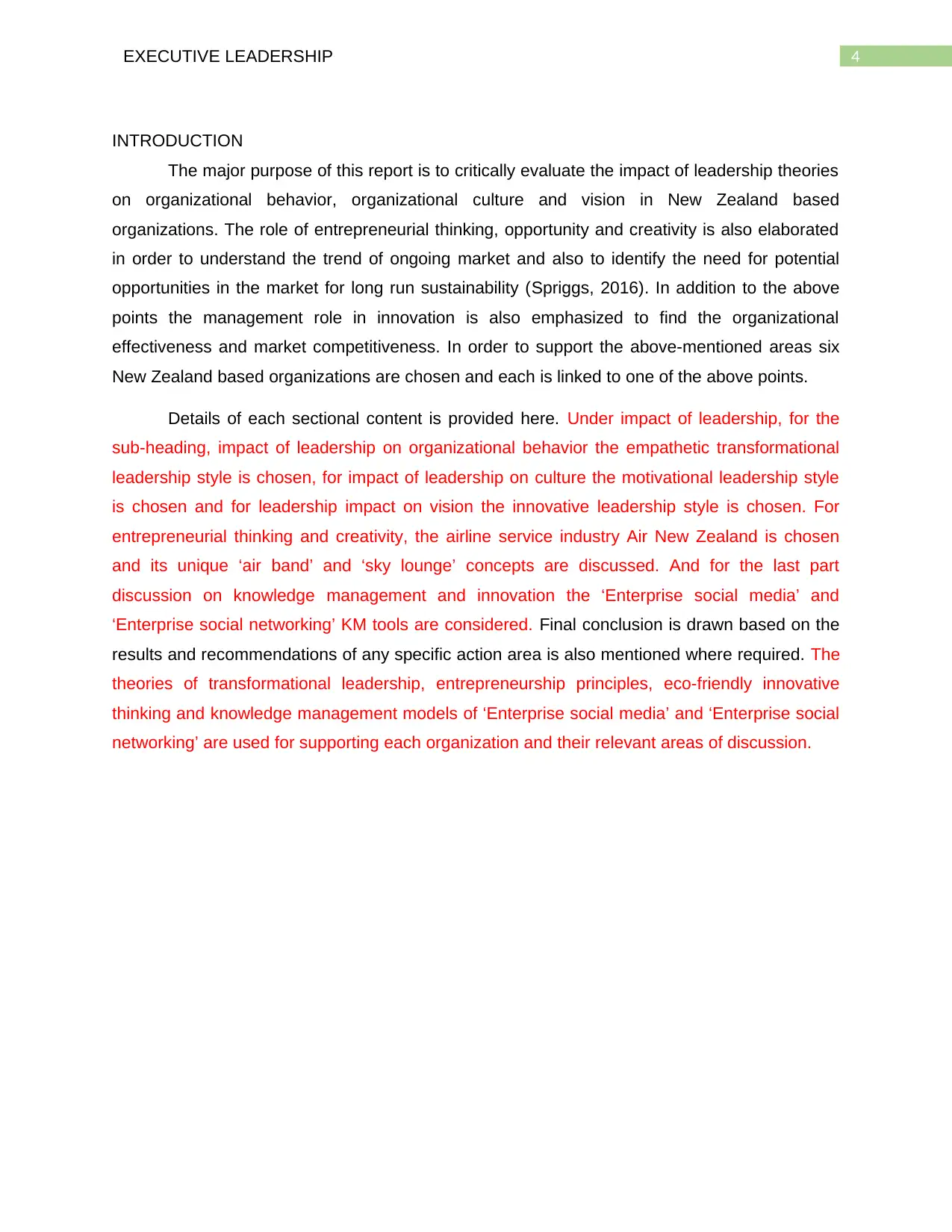
4EXECUTIVE LEADERSHIP
INTRODUCTION
The major purpose of this report is to critically evaluate the impact of leadership theories
on organizational behavior, organizational culture and vision in New Zealand based
organizations. The role of entrepreneurial thinking, opportunity and creativity is also elaborated
in order to understand the trend of ongoing market and also to identify the need for potential
opportunities in the market for long run sustainability (Spriggs, 2016). In addition to the above
points the management role in innovation is also emphasized to find the organizational
effectiveness and market competitiveness. In order to support the above-mentioned areas six
New Zealand based organizations are chosen and each is linked to one of the above points.
Details of each sectional content is provided here. Under impact of leadership, for the
sub-heading, impact of leadership on organizational behavior the empathetic transformational
leadership style is chosen, for impact of leadership on culture the motivational leadership style
is chosen and for leadership impact on vision the innovative leadership style is chosen. For
entrepreneurial thinking and creativity, the airline service industry Air New Zealand is chosen
and its unique ‘air band’ and ‘sky lounge’ concepts are discussed. And for the last part
discussion on knowledge management and innovation the ‘Enterprise social media’ and
‘Enterprise social networking’ KM tools are considered. Final conclusion is drawn based on the
results and recommendations of any specific action area is also mentioned where required. The
theories of transformational leadership, entrepreneurship principles, eco-friendly innovative
thinking and knowledge management models of ‘Enterprise social media’ and ‘Enterprise social
networking’ are used for supporting each organization and their relevant areas of discussion.
INTRODUCTION
The major purpose of this report is to critically evaluate the impact of leadership theories
on organizational behavior, organizational culture and vision in New Zealand based
organizations. The role of entrepreneurial thinking, opportunity and creativity is also elaborated
in order to understand the trend of ongoing market and also to identify the need for potential
opportunities in the market for long run sustainability (Spriggs, 2016). In addition to the above
points the management role in innovation is also emphasized to find the organizational
effectiveness and market competitiveness. In order to support the above-mentioned areas six
New Zealand based organizations are chosen and each is linked to one of the above points.
Details of each sectional content is provided here. Under impact of leadership, for the
sub-heading, impact of leadership on organizational behavior the empathetic transformational
leadership style is chosen, for impact of leadership on culture the motivational leadership style
is chosen and for leadership impact on vision the innovative leadership style is chosen. For
entrepreneurial thinking and creativity, the airline service industry Air New Zealand is chosen
and its unique ‘air band’ and ‘sky lounge’ concepts are discussed. And for the last part
discussion on knowledge management and innovation the ‘Enterprise social media’ and
‘Enterprise social networking’ KM tools are considered. Final conclusion is drawn based on the
results and recommendations of any specific action area is also mentioned where required. The
theories of transformational leadership, entrepreneurship principles, eco-friendly innovative
thinking and knowledge management models of ‘Enterprise social media’ and ‘Enterprise social
networking’ are used for supporting each organization and their relevant areas of discussion.
Paraphrase This Document
Need a fresh take? Get an instant paraphrase of this document with our AI Paraphraser
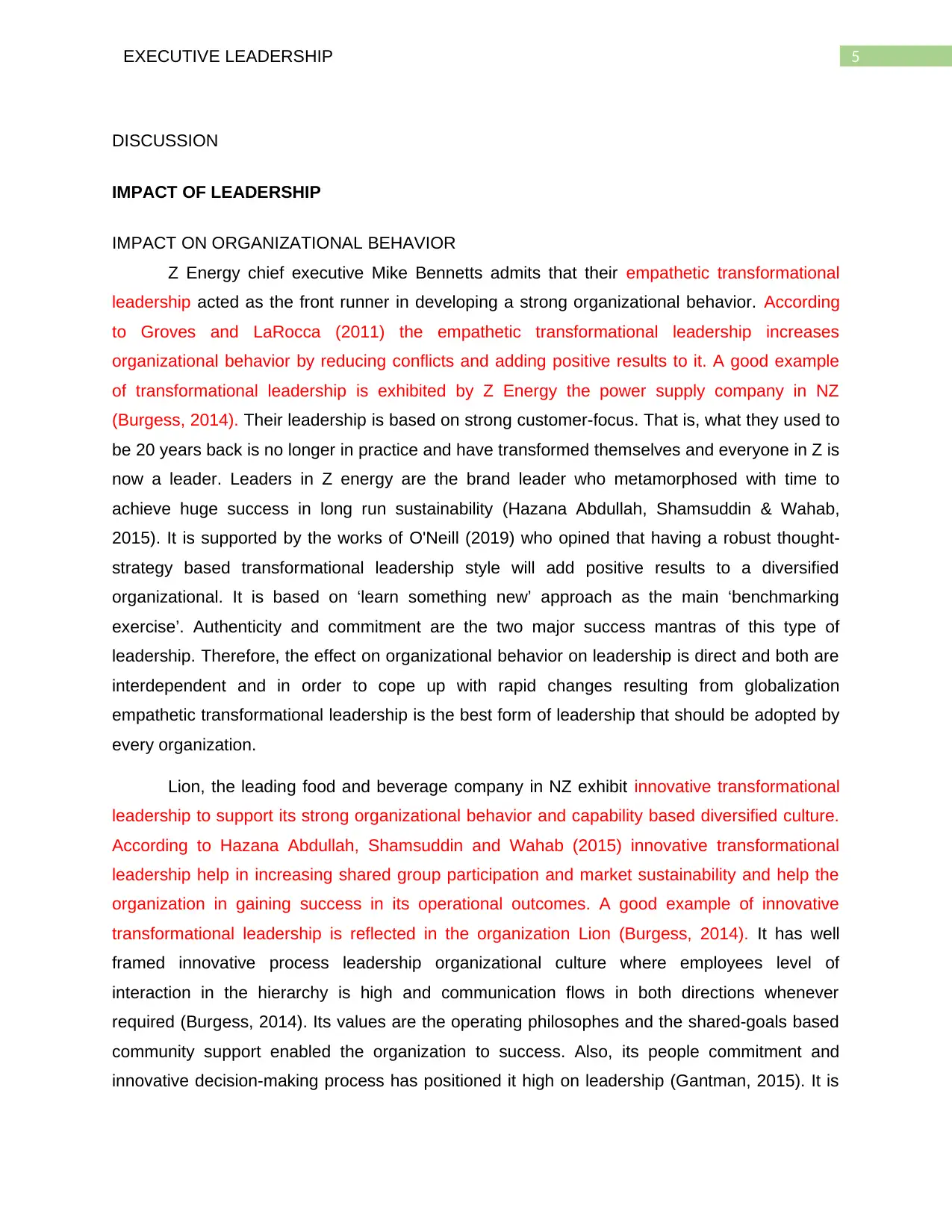
5EXECUTIVE LEADERSHIP
DISCUSSION
IMPACT OF LEADERSHIP
IMPACT ON ORGANIZATIONAL BEHAVIOR
Z Energy chief executive Mike Bennetts admits that their empathetic transformational
leadership acted as the front runner in developing a strong organizational behavior. According
to Groves and LaRocca (2011) the empathetic transformational leadership increases
organizational behavior by reducing conflicts and adding positive results to it. A good example
of transformational leadership is exhibited by Z Energy the power supply company in NZ
(Burgess, 2014). Their leadership is based on strong customer-focus. That is, what they used to
be 20 years back is no longer in practice and have transformed themselves and everyone in Z is
now a leader. Leaders in Z energy are the brand leader who metamorphosed with time to
achieve huge success in long run sustainability (Hazana Abdullah, Shamsuddin & Wahab,
2015). It is supported by the works of O'Neill (2019) who opined that having a robust thought-
strategy based transformational leadership style will add positive results to a diversified
organizational. It is based on ‘learn something new’ approach as the main ‘benchmarking
exercise’. Authenticity and commitment are the two major success mantras of this type of
leadership. Therefore, the effect on organizational behavior on leadership is direct and both are
interdependent and in order to cope up with rapid changes resulting from globalization
empathetic transformational leadership is the best form of leadership that should be adopted by
every organization.
Lion, the leading food and beverage company in NZ exhibit innovative transformational
leadership to support its strong organizational behavior and capability based diversified culture.
According to Hazana Abdullah, Shamsuddin and Wahab (2015) innovative transformational
leadership help in increasing shared group participation and market sustainability and help the
organization in gaining success in its operational outcomes. A good example of innovative
transformational leadership is reflected in the organization Lion (Burgess, 2014). It has well
framed innovative process leadership organizational culture where employees level of
interaction in the hierarchy is high and communication flows in both directions whenever
required (Burgess, 2014). Its values are the operating philosophes and the shared-goals based
community support enabled the organization to success. Also, its people commitment and
innovative decision-making process has positioned it high on leadership (Gantman, 2015). It is
DISCUSSION
IMPACT OF LEADERSHIP
IMPACT ON ORGANIZATIONAL BEHAVIOR
Z Energy chief executive Mike Bennetts admits that their empathetic transformational
leadership acted as the front runner in developing a strong organizational behavior. According
to Groves and LaRocca (2011) the empathetic transformational leadership increases
organizational behavior by reducing conflicts and adding positive results to it. A good example
of transformational leadership is exhibited by Z Energy the power supply company in NZ
(Burgess, 2014). Their leadership is based on strong customer-focus. That is, what they used to
be 20 years back is no longer in practice and have transformed themselves and everyone in Z is
now a leader. Leaders in Z energy are the brand leader who metamorphosed with time to
achieve huge success in long run sustainability (Hazana Abdullah, Shamsuddin & Wahab,
2015). It is supported by the works of O'Neill (2019) who opined that having a robust thought-
strategy based transformational leadership style will add positive results to a diversified
organizational. It is based on ‘learn something new’ approach as the main ‘benchmarking
exercise’. Authenticity and commitment are the two major success mantras of this type of
leadership. Therefore, the effect on organizational behavior on leadership is direct and both are
interdependent and in order to cope up with rapid changes resulting from globalization
empathetic transformational leadership is the best form of leadership that should be adopted by
every organization.
Lion, the leading food and beverage company in NZ exhibit innovative transformational
leadership to support its strong organizational behavior and capability based diversified culture.
According to Hazana Abdullah, Shamsuddin and Wahab (2015) innovative transformational
leadership help in increasing shared group participation and market sustainability and help the
organization in gaining success in its operational outcomes. A good example of innovative
transformational leadership is reflected in the organization Lion (Burgess, 2014). It has well
framed innovative process leadership organizational culture where employees level of
interaction in the hierarchy is high and communication flows in both directions whenever
required (Burgess, 2014). Its values are the operating philosophes and the shared-goals based
community support enabled the organization to success. Also, its people commitment and
innovative decision-making process has positioned it high on leadership (Gantman, 2015). It is
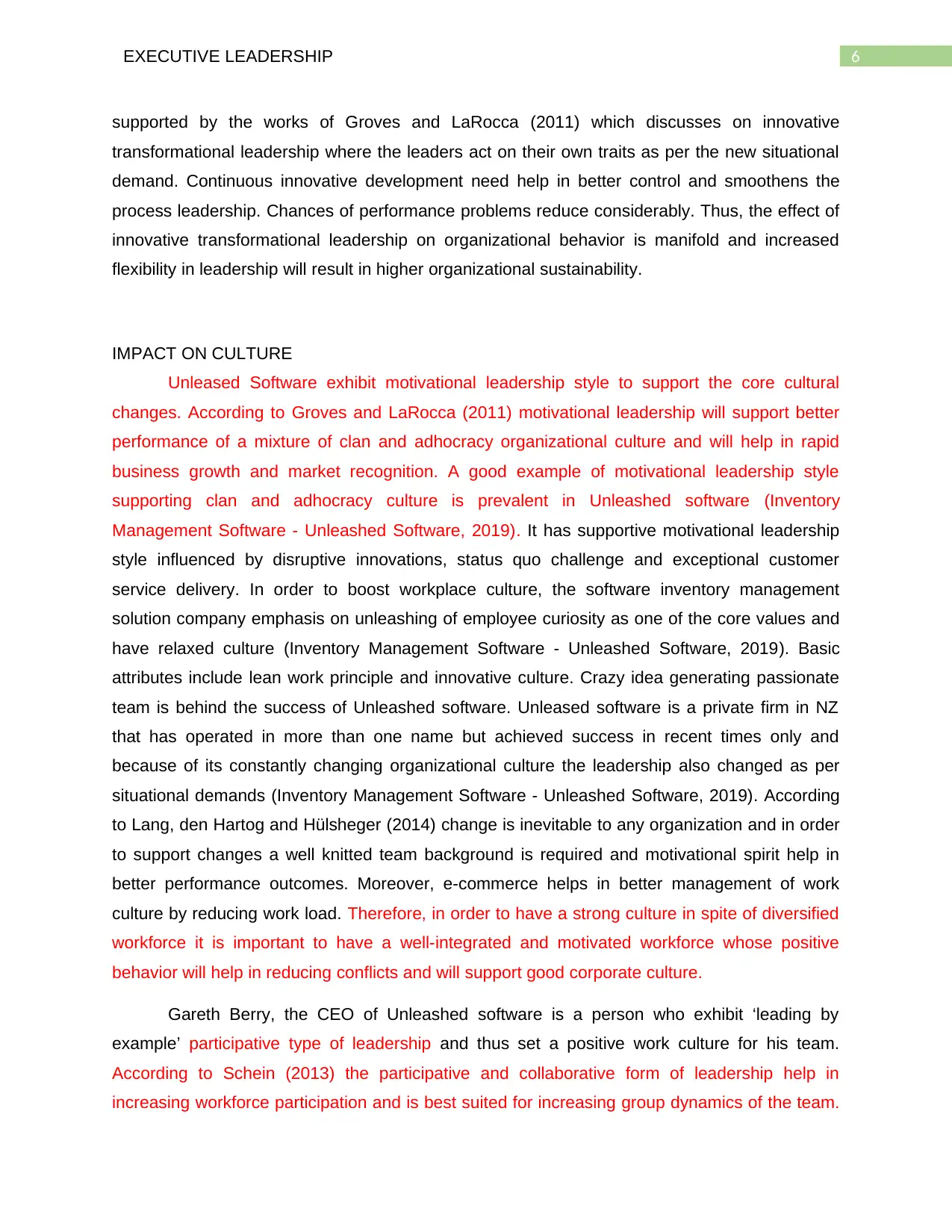
6EXECUTIVE LEADERSHIP
supported by the works of Groves and LaRocca (2011) which discusses on innovative
transformational leadership where the leaders act on their own traits as per the new situational
demand. Continuous innovative development need help in better control and smoothens the
process leadership. Chances of performance problems reduce considerably. Thus, the effect of
innovative transformational leadership on organizational behavior is manifold and increased
flexibility in leadership will result in higher organizational sustainability.
IMPACT ON CULTURE
Unleased Software exhibit motivational leadership style to support the core cultural
changes. According to Groves and LaRocca (2011) motivational leadership will support better
performance of a mixture of clan and adhocracy organizational culture and will help in rapid
business growth and market recognition. A good example of motivational leadership style
supporting clan and adhocracy culture is prevalent in Unleashed software (Inventory
Management Software - Unleashed Software, 2019). It has supportive motivational leadership
style influenced by disruptive innovations, status quo challenge and exceptional customer
service delivery. In order to boost workplace culture, the software inventory management
solution company emphasis on unleashing of employee curiosity as one of the core values and
have relaxed culture (Inventory Management Software - Unleashed Software, 2019). Basic
attributes include lean work principle and innovative culture. Crazy idea generating passionate
team is behind the success of Unleashed software. Unleased software is a private firm in NZ
that has operated in more than one name but achieved success in recent times only and
because of its constantly changing organizational culture the leadership also changed as per
situational demands (Inventory Management Software - Unleashed Software, 2019). According
to Lang, den Hartog and Hülsheger (2014) change is inevitable to any organization and in order
to support changes a well knitted team background is required and motivational spirit help in
better performance outcomes. Moreover, e-commerce helps in better management of work
culture by reducing work load. Therefore, in order to have a strong culture in spite of diversified
workforce it is important to have a well-integrated and motivated workforce whose positive
behavior will help in reducing conflicts and will support good corporate culture.
Gareth Berry, the CEO of Unleashed software is a person who exhibit ‘leading by
example’ participative type of leadership and thus set a positive work culture for his team.
According to Schein (2013) the participative and collaborative form of leadership help in
increasing workforce participation and is best suited for increasing group dynamics of the team.
supported by the works of Groves and LaRocca (2011) which discusses on innovative
transformational leadership where the leaders act on their own traits as per the new situational
demand. Continuous innovative development need help in better control and smoothens the
process leadership. Chances of performance problems reduce considerably. Thus, the effect of
innovative transformational leadership on organizational behavior is manifold and increased
flexibility in leadership will result in higher organizational sustainability.
IMPACT ON CULTURE
Unleased Software exhibit motivational leadership style to support the core cultural
changes. According to Groves and LaRocca (2011) motivational leadership will support better
performance of a mixture of clan and adhocracy organizational culture and will help in rapid
business growth and market recognition. A good example of motivational leadership style
supporting clan and adhocracy culture is prevalent in Unleashed software (Inventory
Management Software - Unleashed Software, 2019). It has supportive motivational leadership
style influenced by disruptive innovations, status quo challenge and exceptional customer
service delivery. In order to boost workplace culture, the software inventory management
solution company emphasis on unleashing of employee curiosity as one of the core values and
have relaxed culture (Inventory Management Software - Unleashed Software, 2019). Basic
attributes include lean work principle and innovative culture. Crazy idea generating passionate
team is behind the success of Unleashed software. Unleased software is a private firm in NZ
that has operated in more than one name but achieved success in recent times only and
because of its constantly changing organizational culture the leadership also changed as per
situational demands (Inventory Management Software - Unleashed Software, 2019). According
to Lang, den Hartog and Hülsheger (2014) change is inevitable to any organization and in order
to support changes a well knitted team background is required and motivational spirit help in
better performance outcomes. Moreover, e-commerce helps in better management of work
culture by reducing work load. Therefore, in order to have a strong culture in spite of diversified
workforce it is important to have a well-integrated and motivated workforce whose positive
behavior will help in reducing conflicts and will support good corporate culture.
Gareth Berry, the CEO of Unleashed software is a person who exhibit ‘leading by
example’ participative type of leadership and thus set a positive work culture for his team.
According to Schein (2013) the participative and collaborative form of leadership help in
increasing workforce participation and is best suited for increasing group dynamics of the team.
⊘ This is a preview!⊘
Do you want full access?
Subscribe today to unlock all pages.

Trusted by 1+ million students worldwide
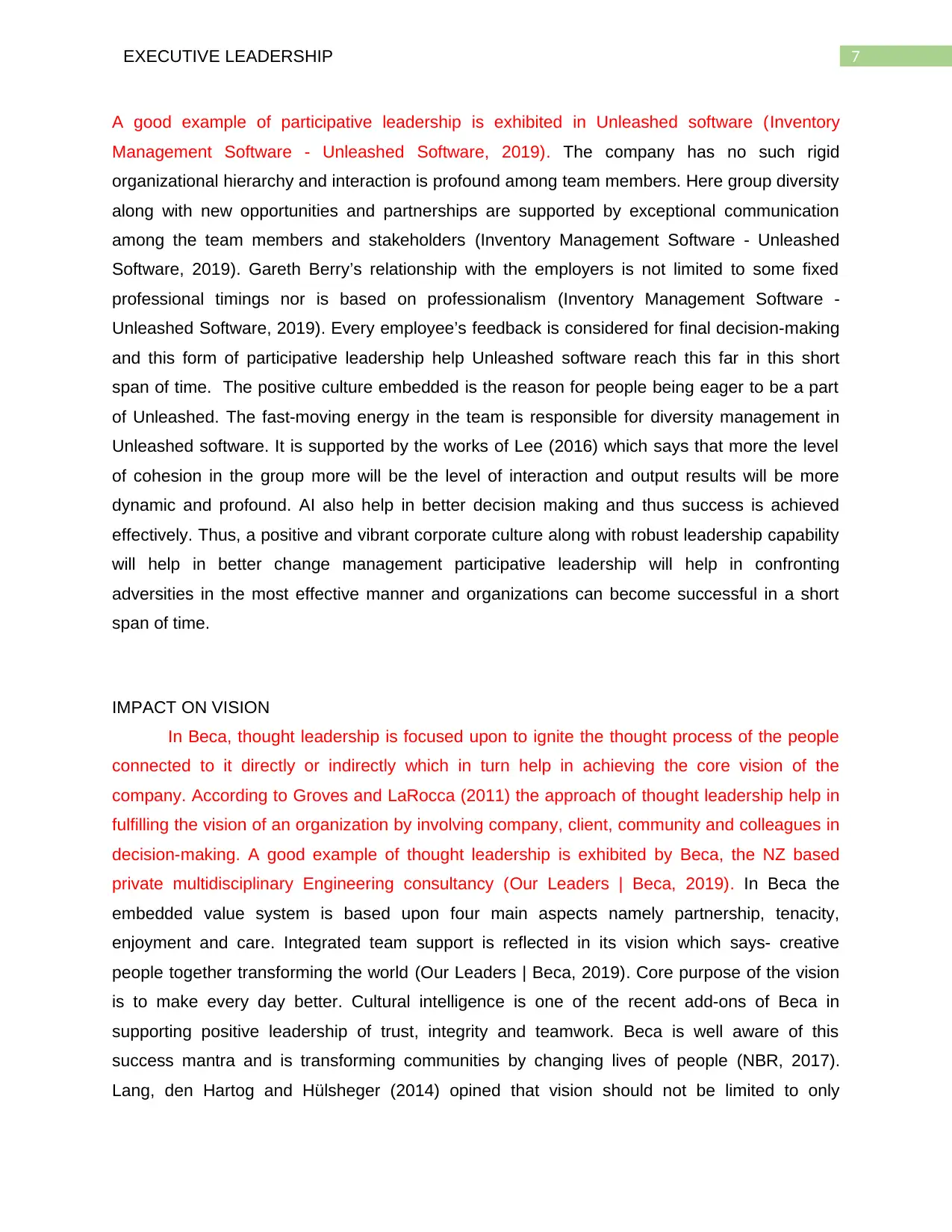
7EXECUTIVE LEADERSHIP
A good example of participative leadership is exhibited in Unleashed software (Inventory
Management Software - Unleashed Software, 2019). The company has no such rigid
organizational hierarchy and interaction is profound among team members. Here group diversity
along with new opportunities and partnerships are supported by exceptional communication
among the team members and stakeholders (Inventory Management Software - Unleashed
Software, 2019). Gareth Berry’s relationship with the employers is not limited to some fixed
professional timings nor is based on professionalism (Inventory Management Software -
Unleashed Software, 2019). Every employee’s feedback is considered for final decision-making
and this form of participative leadership help Unleashed software reach this far in this short
span of time. The positive culture embedded is the reason for people being eager to be a part
of Unleashed. The fast-moving energy in the team is responsible for diversity management in
Unleashed software. It is supported by the works of Lee (2016) which says that more the level
of cohesion in the group more will be the level of interaction and output results will be more
dynamic and profound. AI also help in better decision making and thus success is achieved
effectively. Thus, a positive and vibrant corporate culture along with robust leadership capability
will help in better change management participative leadership will help in confronting
adversities in the most effective manner and organizations can become successful in a short
span of time.
IMPACT ON VISION
In Beca, thought leadership is focused upon to ignite the thought process of the people
connected to it directly or indirectly which in turn help in achieving the core vision of the
company. According to Groves and LaRocca (2011) the approach of thought leadership help in
fulfilling the vision of an organization by involving company, client, community and colleagues in
decision-making. A good example of thought leadership is exhibited by Beca, the NZ based
private multidisciplinary Engineering consultancy (Our Leaders | Beca, 2019). In Beca the
embedded value system is based upon four main aspects namely partnership, tenacity,
enjoyment and care. Integrated team support is reflected in its vision which says- creative
people together transforming the world (Our Leaders | Beca, 2019). Core purpose of the vision
is to make every day better. Cultural intelligence is one of the recent add-ons of Beca in
supporting positive leadership of trust, integrity and teamwork. Beca is well aware of this
success mantra and is transforming communities by changing lives of people (NBR, 2017).
Lang, den Hartog and Hülsheger (2014) opined that vision should not be limited to only
A good example of participative leadership is exhibited in Unleashed software (Inventory
Management Software - Unleashed Software, 2019). The company has no such rigid
organizational hierarchy and interaction is profound among team members. Here group diversity
along with new opportunities and partnerships are supported by exceptional communication
among the team members and stakeholders (Inventory Management Software - Unleashed
Software, 2019). Gareth Berry’s relationship with the employers is not limited to some fixed
professional timings nor is based on professionalism (Inventory Management Software -
Unleashed Software, 2019). Every employee’s feedback is considered for final decision-making
and this form of participative leadership help Unleashed software reach this far in this short
span of time. The positive culture embedded is the reason for people being eager to be a part
of Unleashed. The fast-moving energy in the team is responsible for diversity management in
Unleashed software. It is supported by the works of Lee (2016) which says that more the level
of cohesion in the group more will be the level of interaction and output results will be more
dynamic and profound. AI also help in better decision making and thus success is achieved
effectively. Thus, a positive and vibrant corporate culture along with robust leadership capability
will help in better change management participative leadership will help in confronting
adversities in the most effective manner and organizations can become successful in a short
span of time.
IMPACT ON VISION
In Beca, thought leadership is focused upon to ignite the thought process of the people
connected to it directly or indirectly which in turn help in achieving the core vision of the
company. According to Groves and LaRocca (2011) the approach of thought leadership help in
fulfilling the vision of an organization by involving company, client, community and colleagues in
decision-making. A good example of thought leadership is exhibited by Beca, the NZ based
private multidisciplinary Engineering consultancy (Our Leaders | Beca, 2019). In Beca the
embedded value system is based upon four main aspects namely partnership, tenacity,
enjoyment and care. Integrated team support is reflected in its vision which says- creative
people together transforming the world (Our Leaders | Beca, 2019). Core purpose of the vision
is to make every day better. Cultural intelligence is one of the recent add-ons of Beca in
supporting positive leadership of trust, integrity and teamwork. Beca is well aware of this
success mantra and is transforming communities by changing lives of people (NBR, 2017).
Lang, den Hartog and Hülsheger (2014) opined that vision should not be limited to only
Paraphrase This Document
Need a fresh take? Get an instant paraphrase of this document with our AI Paraphraser
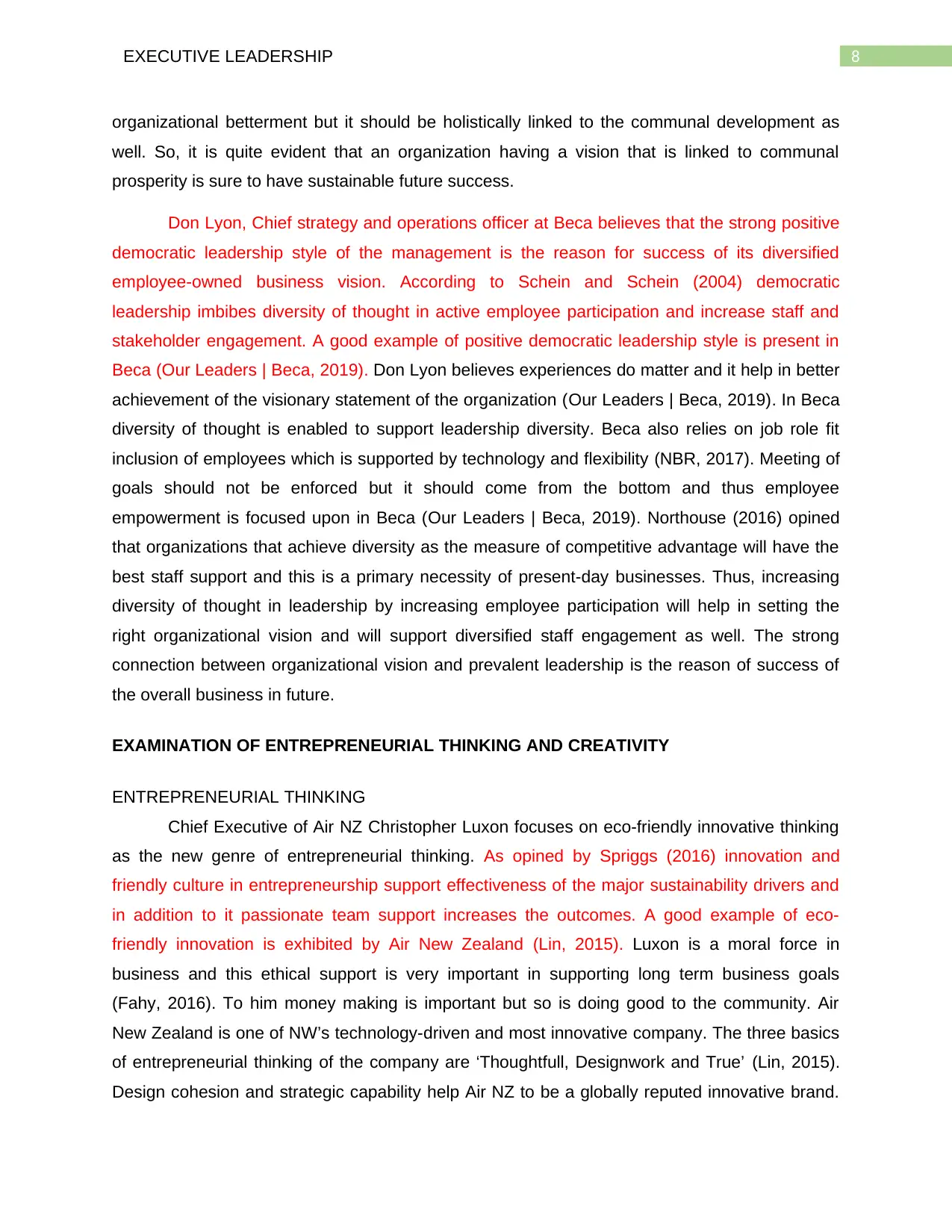
8EXECUTIVE LEADERSHIP
organizational betterment but it should be holistically linked to the communal development as
well. So, it is quite evident that an organization having a vision that is linked to communal
prosperity is sure to have sustainable future success.
Don Lyon, Chief strategy and operations officer at Beca believes that the strong positive
democratic leadership style of the management is the reason for success of its diversified
employee-owned business vision. According to Schein and Schein (2004) democratic
leadership imbibes diversity of thought in active employee participation and increase staff and
stakeholder engagement. A good example of positive democratic leadership style is present in
Beca (Our Leaders | Beca, 2019). Don Lyon believes experiences do matter and it help in better
achievement of the visionary statement of the organization (Our Leaders | Beca, 2019). In Beca
diversity of thought is enabled to support leadership diversity. Beca also relies on job role fit
inclusion of employees which is supported by technology and flexibility (NBR, 2017). Meeting of
goals should not be enforced but it should come from the bottom and thus employee
empowerment is focused upon in Beca (Our Leaders | Beca, 2019). Northouse (2016) opined
that organizations that achieve diversity as the measure of competitive advantage will have the
best staff support and this is a primary necessity of present-day businesses. Thus, increasing
diversity of thought in leadership by increasing employee participation will help in setting the
right organizational vision and will support diversified staff engagement as well. The strong
connection between organizational vision and prevalent leadership is the reason of success of
the overall business in future.
EXAMINATION OF ENTREPRENEURIAL THINKING AND CREATIVITY
ENTREPRENEURIAL THINKING
Chief Executive of Air NZ Christopher Luxon focuses on eco-friendly innovative thinking
as the new genre of entrepreneurial thinking. As opined by Spriggs (2016) innovation and
friendly culture in entrepreneurship support effectiveness of the major sustainability drivers and
in addition to it passionate team support increases the outcomes. A good example of eco-
friendly innovation is exhibited by Air New Zealand (Lin, 2015). Luxon is a moral force in
business and this ethical support is very important in supporting long term business goals
(Fahy, 2016). To him money making is important but so is doing good to the community. Air
New Zealand is one of NW’s technology-driven and most innovative company. The three basics
of entrepreneurial thinking of the company are ‘Thoughtfull, Designwork and True’ (Lin, 2015).
Design cohesion and strategic capability help Air NZ to be a globally reputed innovative brand.
organizational betterment but it should be holistically linked to the communal development as
well. So, it is quite evident that an organization having a vision that is linked to communal
prosperity is sure to have sustainable future success.
Don Lyon, Chief strategy and operations officer at Beca believes that the strong positive
democratic leadership style of the management is the reason for success of its diversified
employee-owned business vision. According to Schein and Schein (2004) democratic
leadership imbibes diversity of thought in active employee participation and increase staff and
stakeholder engagement. A good example of positive democratic leadership style is present in
Beca (Our Leaders | Beca, 2019). Don Lyon believes experiences do matter and it help in better
achievement of the visionary statement of the organization (Our Leaders | Beca, 2019). In Beca
diversity of thought is enabled to support leadership diversity. Beca also relies on job role fit
inclusion of employees which is supported by technology and flexibility (NBR, 2017). Meeting of
goals should not be enforced but it should come from the bottom and thus employee
empowerment is focused upon in Beca (Our Leaders | Beca, 2019). Northouse (2016) opined
that organizations that achieve diversity as the measure of competitive advantage will have the
best staff support and this is a primary necessity of present-day businesses. Thus, increasing
diversity of thought in leadership by increasing employee participation will help in setting the
right organizational vision and will support diversified staff engagement as well. The strong
connection between organizational vision and prevalent leadership is the reason of success of
the overall business in future.
EXAMINATION OF ENTREPRENEURIAL THINKING AND CREATIVITY
ENTREPRENEURIAL THINKING
Chief Executive of Air NZ Christopher Luxon focuses on eco-friendly innovative thinking
as the new genre of entrepreneurial thinking. As opined by Spriggs (2016) innovation and
friendly culture in entrepreneurship support effectiveness of the major sustainability drivers and
in addition to it passionate team support increases the outcomes. A good example of eco-
friendly innovation is exhibited by Air New Zealand (Lin, 2015). Luxon is a moral force in
business and this ethical support is very important in supporting long term business goals
(Fahy, 2016). To him money making is important but so is doing good to the community. Air
New Zealand is one of NW’s technology-driven and most innovative company. The three basics
of entrepreneurial thinking of the company are ‘Thoughtfull, Designwork and True’ (Lin, 2015).
Design cohesion and strategic capability help Air NZ to be a globally reputed innovative brand.
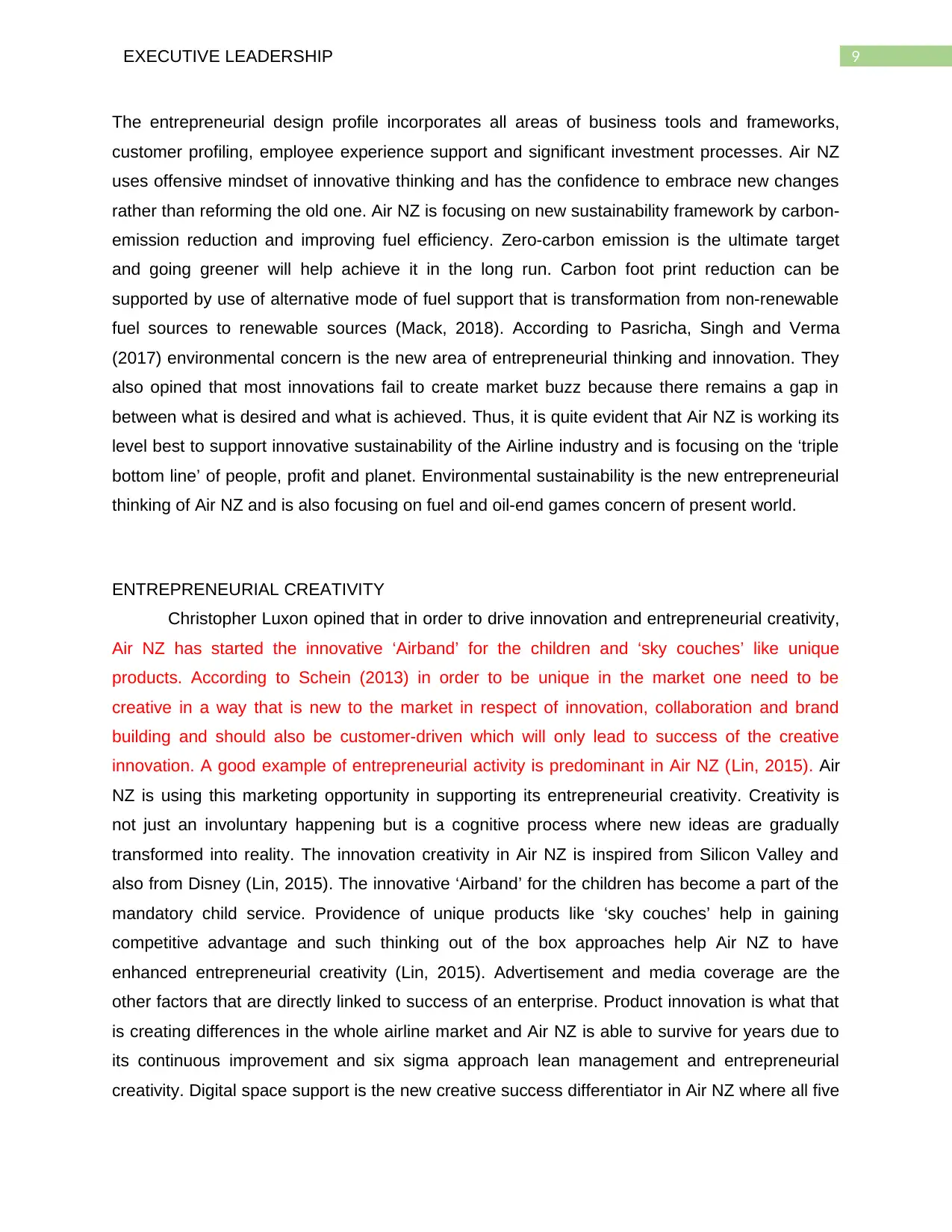
9EXECUTIVE LEADERSHIP
The entrepreneurial design profile incorporates all areas of business tools and frameworks,
customer profiling, employee experience support and significant investment processes. Air NZ
uses offensive mindset of innovative thinking and has the confidence to embrace new changes
rather than reforming the old one. Air NZ is focusing on new sustainability framework by carbon-
emission reduction and improving fuel efficiency. Zero-carbon emission is the ultimate target
and going greener will help achieve it in the long run. Carbon foot print reduction can be
supported by use of alternative mode of fuel support that is transformation from non-renewable
fuel sources to renewable sources (Mack, 2018). According to Pasricha, Singh and Verma
(2017) environmental concern is the new area of entrepreneurial thinking and innovation. They
also opined that most innovations fail to create market buzz because there remains a gap in
between what is desired and what is achieved. Thus, it is quite evident that Air NZ is working its
level best to support innovative sustainability of the Airline industry and is focusing on the ‘triple
bottom line’ of people, profit and planet. Environmental sustainability is the new entrepreneurial
thinking of Air NZ and is also focusing on fuel and oil-end games concern of present world.
ENTREPRENEURIAL CREATIVITY
Christopher Luxon opined that in order to drive innovation and entrepreneurial creativity,
Air NZ has started the innovative ‘Airband’ for the children and ‘sky couches’ like unique
products. According to Schein (2013) in order to be unique in the market one need to be
creative in a way that is new to the market in respect of innovation, collaboration and brand
building and should also be customer-driven which will only lead to success of the creative
innovation. A good example of entrepreneurial activity is predominant in Air NZ (Lin, 2015). Air
NZ is using this marketing opportunity in supporting its entrepreneurial creativity. Creativity is
not just an involuntary happening but is a cognitive process where new ideas are gradually
transformed into reality. The innovation creativity in Air NZ is inspired from Silicon Valley and
also from Disney (Lin, 2015). The innovative ‘Airband’ for the children has become a part of the
mandatory child service. Providence of unique products like ‘sky couches’ help in gaining
competitive advantage and such thinking out of the box approaches help Air NZ to have
enhanced entrepreneurial creativity (Lin, 2015). Advertisement and media coverage are the
other factors that are directly linked to success of an enterprise. Product innovation is what that
is creating differences in the whole airline market and Air NZ is able to survive for years due to
its continuous improvement and six sigma approach lean management and entrepreneurial
creativity. Digital space support is the new creative success differentiator in Air NZ where all five
The entrepreneurial design profile incorporates all areas of business tools and frameworks,
customer profiling, employee experience support and significant investment processes. Air NZ
uses offensive mindset of innovative thinking and has the confidence to embrace new changes
rather than reforming the old one. Air NZ is focusing on new sustainability framework by carbon-
emission reduction and improving fuel efficiency. Zero-carbon emission is the ultimate target
and going greener will help achieve it in the long run. Carbon foot print reduction can be
supported by use of alternative mode of fuel support that is transformation from non-renewable
fuel sources to renewable sources (Mack, 2018). According to Pasricha, Singh and Verma
(2017) environmental concern is the new area of entrepreneurial thinking and innovation. They
also opined that most innovations fail to create market buzz because there remains a gap in
between what is desired and what is achieved. Thus, it is quite evident that Air NZ is working its
level best to support innovative sustainability of the Airline industry and is focusing on the ‘triple
bottom line’ of people, profit and planet. Environmental sustainability is the new entrepreneurial
thinking of Air NZ and is also focusing on fuel and oil-end games concern of present world.
ENTREPRENEURIAL CREATIVITY
Christopher Luxon opined that in order to drive innovation and entrepreneurial creativity,
Air NZ has started the innovative ‘Airband’ for the children and ‘sky couches’ like unique
products. According to Schein (2013) in order to be unique in the market one need to be
creative in a way that is new to the market in respect of innovation, collaboration and brand
building and should also be customer-driven which will only lead to success of the creative
innovation. A good example of entrepreneurial activity is predominant in Air NZ (Lin, 2015). Air
NZ is using this marketing opportunity in supporting its entrepreneurial creativity. Creativity is
not just an involuntary happening but is a cognitive process where new ideas are gradually
transformed into reality. The innovation creativity in Air NZ is inspired from Silicon Valley and
also from Disney (Lin, 2015). The innovative ‘Airband’ for the children has become a part of the
mandatory child service. Providence of unique products like ‘sky couches’ help in gaining
competitive advantage and such thinking out of the box approaches help Air NZ to have
enhanced entrepreneurial creativity (Lin, 2015). Advertisement and media coverage are the
other factors that are directly linked to success of an enterprise. Product innovation is what that
is creating differences in the whole airline market and Air NZ is able to survive for years due to
its continuous improvement and six sigma approach lean management and entrepreneurial
creativity. Digital space support is the new creative success differentiator in Air NZ where all five
⊘ This is a preview!⊘
Do you want full access?
Subscribe today to unlock all pages.

Trusted by 1+ million students worldwide
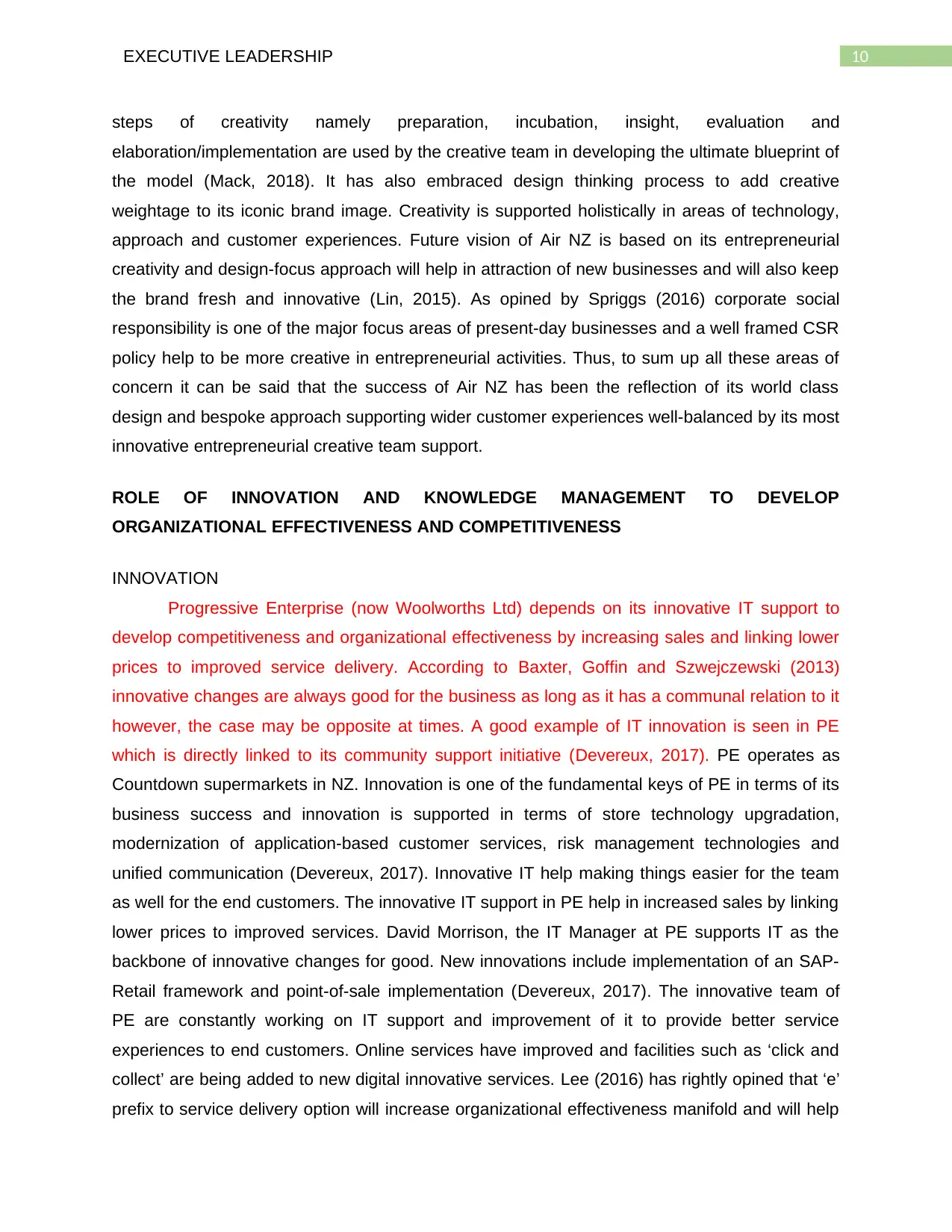
10EXECUTIVE LEADERSHIP
steps of creativity namely preparation, incubation, insight, evaluation and
elaboration/implementation are used by the creative team in developing the ultimate blueprint of
the model (Mack, 2018). It has also embraced design thinking process to add creative
weightage to its iconic brand image. Creativity is supported holistically in areas of technology,
approach and customer experiences. Future vision of Air NZ is based on its entrepreneurial
creativity and design-focus approach will help in attraction of new businesses and will also keep
the brand fresh and innovative (Lin, 2015). As opined by Spriggs (2016) corporate social
responsibility is one of the major focus areas of present-day businesses and a well framed CSR
policy help to be more creative in entrepreneurial activities. Thus, to sum up all these areas of
concern it can be said that the success of Air NZ has been the reflection of its world class
design and bespoke approach supporting wider customer experiences well-balanced by its most
innovative entrepreneurial creative team support.
ROLE OF INNOVATION AND KNOWLEDGE MANAGEMENT TO DEVELOP
ORGANIZATIONAL EFFECTIVENESS AND COMPETITIVENESS
INNOVATION
Progressive Enterprise (now Woolworths Ltd) depends on its innovative IT support to
develop competitiveness and organizational effectiveness by increasing sales and linking lower
prices to improved service delivery. According to Baxter, Goffin and Szwejczewski (2013)
innovative changes are always good for the business as long as it has a communal relation to it
however, the case may be opposite at times. A good example of IT innovation is seen in PE
which is directly linked to its community support initiative (Devereux, 2017). PE operates as
Countdown supermarkets in NZ. Innovation is one of the fundamental keys of PE in terms of its
business success and innovation is supported in terms of store technology upgradation,
modernization of application-based customer services, risk management technologies and
unified communication (Devereux, 2017). Innovative IT help making things easier for the team
as well for the end customers. The innovative IT support in PE help in increased sales by linking
lower prices to improved services. David Morrison, the IT Manager at PE supports IT as the
backbone of innovative changes for good. New innovations include implementation of an SAP-
Retail framework and point-of-sale implementation (Devereux, 2017). The innovative team of
PE are constantly working on IT support and improvement of it to provide better service
experiences to end customers. Online services have improved and facilities such as ‘click and
collect’ are being added to new digital innovative services. Lee (2016) has rightly opined that ‘e’
prefix to service delivery option will increase organizational effectiveness manifold and will help
steps of creativity namely preparation, incubation, insight, evaluation and
elaboration/implementation are used by the creative team in developing the ultimate blueprint of
the model (Mack, 2018). It has also embraced design thinking process to add creative
weightage to its iconic brand image. Creativity is supported holistically in areas of technology,
approach and customer experiences. Future vision of Air NZ is based on its entrepreneurial
creativity and design-focus approach will help in attraction of new businesses and will also keep
the brand fresh and innovative (Lin, 2015). As opined by Spriggs (2016) corporate social
responsibility is one of the major focus areas of present-day businesses and a well framed CSR
policy help to be more creative in entrepreneurial activities. Thus, to sum up all these areas of
concern it can be said that the success of Air NZ has been the reflection of its world class
design and bespoke approach supporting wider customer experiences well-balanced by its most
innovative entrepreneurial creative team support.
ROLE OF INNOVATION AND KNOWLEDGE MANAGEMENT TO DEVELOP
ORGANIZATIONAL EFFECTIVENESS AND COMPETITIVENESS
INNOVATION
Progressive Enterprise (now Woolworths Ltd) depends on its innovative IT support to
develop competitiveness and organizational effectiveness by increasing sales and linking lower
prices to improved service delivery. According to Baxter, Goffin and Szwejczewski (2013)
innovative changes are always good for the business as long as it has a communal relation to it
however, the case may be opposite at times. A good example of IT innovation is seen in PE
which is directly linked to its community support initiative (Devereux, 2017). PE operates as
Countdown supermarkets in NZ. Innovation is one of the fundamental keys of PE in terms of its
business success and innovation is supported in terms of store technology upgradation,
modernization of application-based customer services, risk management technologies and
unified communication (Devereux, 2017). Innovative IT help making things easier for the team
as well for the end customers. The innovative IT support in PE help in increased sales by linking
lower prices to improved services. David Morrison, the IT Manager at PE supports IT as the
backbone of innovative changes for good. New innovations include implementation of an SAP-
Retail framework and point-of-sale implementation (Devereux, 2017). The innovative team of
PE are constantly working on IT support and improvement of it to provide better service
experiences to end customers. Online services have improved and facilities such as ‘click and
collect’ are being added to new digital innovative services. Lee (2016) has rightly opined that ‘e’
prefix to service delivery option will increase organizational effectiveness manifold and will help
Paraphrase This Document
Need a fresh take? Get an instant paraphrase of this document with our AI Paraphraser

11EXECUTIVE LEADERSHIP
in gaining competitive advantage to a greater extent. So, what can be concluded from this
discussion is that innovative changes are the key success factor of present-day businesses and
the organizations who lack IT-enabled services find it difficult to sustain in the long run business
race. IT innovation supported by green business environment is the best model for a successful
business.
KNOWLEDGE MANAGEMENT (KM)
According to Dave Chambers, MD of Progressive Enterprises ‘e’ knowledge
management tools of ‘Enterprise social media’ and ‘Enterprise social networking’ are the keys to
its current business success. Baxter, Goffin and Szwejczewski (2013) has truly opined that the
four components of knowledge management namely people, process, tools and organization
play important role in supporting one another in achieving overall organizational goals. A well-
defined knowledge management strategy is seen in Progressive Enterprises (Honig, Lampel &
Drori, 2014). The company uses KM in its core problem-solving, strategic planning, decision-
making and also in areas of dynamic learning (Honig, Lampel & Drori, 2014). The tools of
knowledge management like customer relationship system help in better providence of services
to end customers. Progressive enterprise executives know well how to create, share, use and
manage the knowledge and information in the organization both internally and externally. In
Progressive Enterprises social media has been extensively linked to its KM activities and e-
commerce tools are used for improving online sales and customer satisfaction levels by
improvising services such as ‘click and collect’ (Honig, Lampel & Drori, 2014). The KM tools of
‘Enterprise social media’ and ‘Enterprise social networking’ are used extensively in daily
operations of Progressive enterprises where customers and community are exclusively involved
(Hazana Abdullah, Shamsuddin & Wahab, 2015). Innovative ideas are best placed in their KM
processes and it results in ultimate business success. According to Lee (2016) it is true that KM
is largely concerned with managing contents but it helps business leaders in their best decision-
making capabilities and for that company vision and mission need to be well-structured. So, to
end up the discussion it can be said that KM improves global connectivity and organizational
collaboration by improving content, connection and communication. The operational activities
may differ as per organizational sector but the IT support is of equal importance in each
organization irrespective of their sectoral differences. Similarly, Progressive Enterprises being a
grocery retail chain requires greater KM support for its process automation and is using IT-
enabled Knowledge Management to the best of its knowledge.
in gaining competitive advantage to a greater extent. So, what can be concluded from this
discussion is that innovative changes are the key success factor of present-day businesses and
the organizations who lack IT-enabled services find it difficult to sustain in the long run business
race. IT innovation supported by green business environment is the best model for a successful
business.
KNOWLEDGE MANAGEMENT (KM)
According to Dave Chambers, MD of Progressive Enterprises ‘e’ knowledge
management tools of ‘Enterprise social media’ and ‘Enterprise social networking’ are the keys to
its current business success. Baxter, Goffin and Szwejczewski (2013) has truly opined that the
four components of knowledge management namely people, process, tools and organization
play important role in supporting one another in achieving overall organizational goals. A well-
defined knowledge management strategy is seen in Progressive Enterprises (Honig, Lampel &
Drori, 2014). The company uses KM in its core problem-solving, strategic planning, decision-
making and also in areas of dynamic learning (Honig, Lampel & Drori, 2014). The tools of
knowledge management like customer relationship system help in better providence of services
to end customers. Progressive enterprise executives know well how to create, share, use and
manage the knowledge and information in the organization both internally and externally. In
Progressive Enterprises social media has been extensively linked to its KM activities and e-
commerce tools are used for improving online sales and customer satisfaction levels by
improvising services such as ‘click and collect’ (Honig, Lampel & Drori, 2014). The KM tools of
‘Enterprise social media’ and ‘Enterprise social networking’ are used extensively in daily
operations of Progressive enterprises where customers and community are exclusively involved
(Hazana Abdullah, Shamsuddin & Wahab, 2015). Innovative ideas are best placed in their KM
processes and it results in ultimate business success. According to Lee (2016) it is true that KM
is largely concerned with managing contents but it helps business leaders in their best decision-
making capabilities and for that company vision and mission need to be well-structured. So, to
end up the discussion it can be said that KM improves global connectivity and organizational
collaboration by improving content, connection and communication. The operational activities
may differ as per organizational sector but the IT support is of equal importance in each
organization irrespective of their sectoral differences. Similarly, Progressive Enterprises being a
grocery retail chain requires greater KM support for its process automation and is using IT-
enabled Knowledge Management to the best of its knowledge.
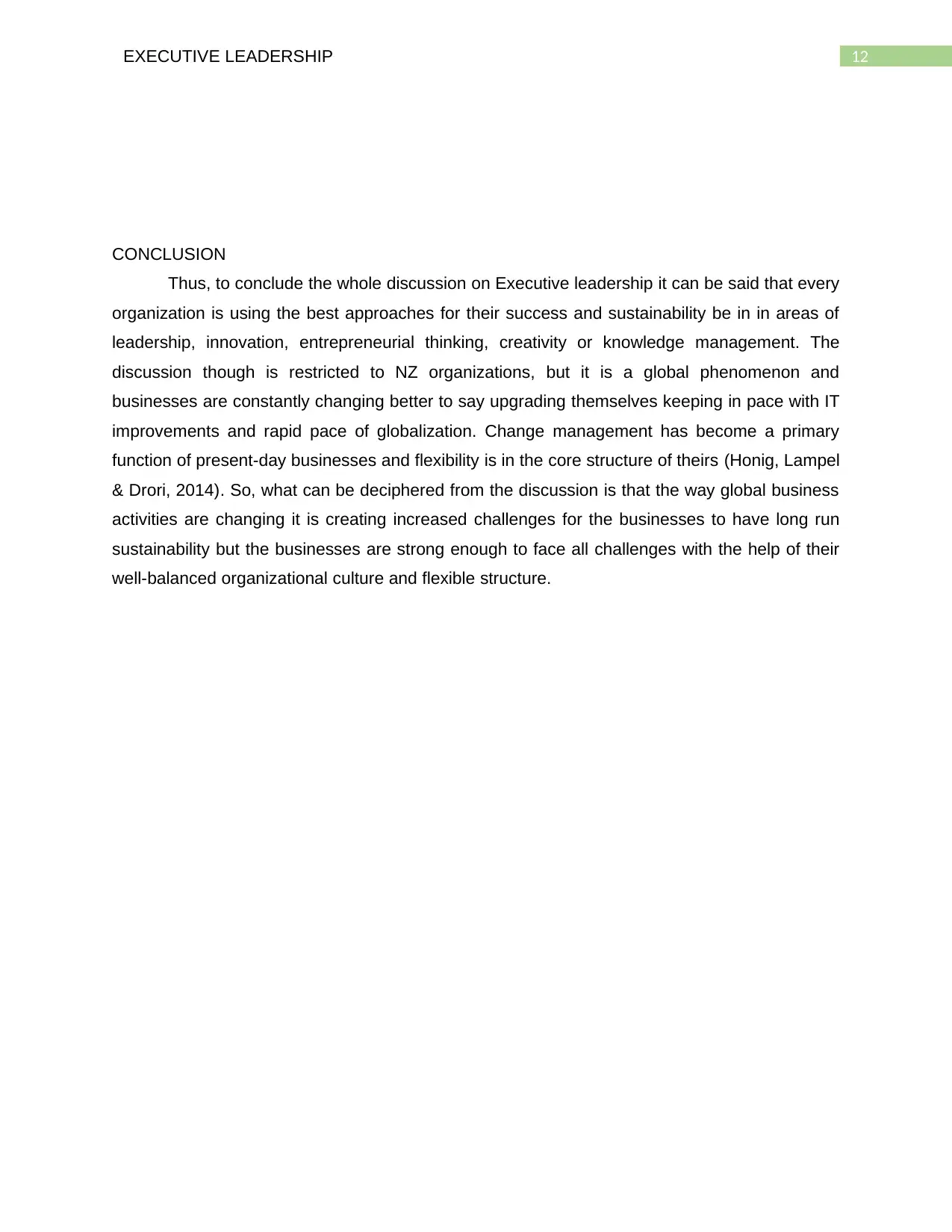
12EXECUTIVE LEADERSHIP
CONCLUSION
Thus, to conclude the whole discussion on Executive leadership it can be said that every
organization is using the best approaches for their success and sustainability be in in areas of
leadership, innovation, entrepreneurial thinking, creativity or knowledge management. The
discussion though is restricted to NZ organizations, but it is a global phenomenon and
businesses are constantly changing better to say upgrading themselves keeping in pace with IT
improvements and rapid pace of globalization. Change management has become a primary
function of present-day businesses and flexibility is in the core structure of theirs (Honig, Lampel
& Drori, 2014). So, what can be deciphered from the discussion is that the way global business
activities are changing it is creating increased challenges for the businesses to have long run
sustainability but the businesses are strong enough to face all challenges with the help of their
well-balanced organizational culture and flexible structure.
CONCLUSION
Thus, to conclude the whole discussion on Executive leadership it can be said that every
organization is using the best approaches for their success and sustainability be in in areas of
leadership, innovation, entrepreneurial thinking, creativity or knowledge management. The
discussion though is restricted to NZ organizations, but it is a global phenomenon and
businesses are constantly changing better to say upgrading themselves keeping in pace with IT
improvements and rapid pace of globalization. Change management has become a primary
function of present-day businesses and flexibility is in the core structure of theirs (Honig, Lampel
& Drori, 2014). So, what can be deciphered from the discussion is that the way global business
activities are changing it is creating increased challenges for the businesses to have long run
sustainability but the businesses are strong enough to face all challenges with the help of their
well-balanced organizational culture and flexible structure.
⊘ This is a preview!⊘
Do you want full access?
Subscribe today to unlock all pages.

Trusted by 1+ million students worldwide
1 out of 17
Related Documents
Your All-in-One AI-Powered Toolkit for Academic Success.
+13062052269
info@desklib.com
Available 24*7 on WhatsApp / Email
![[object Object]](/_next/static/media/star-bottom.7253800d.svg)
Unlock your academic potential
Copyright © 2020–2025 A2Z Services. All Rights Reserved. Developed and managed by ZUCOL.





